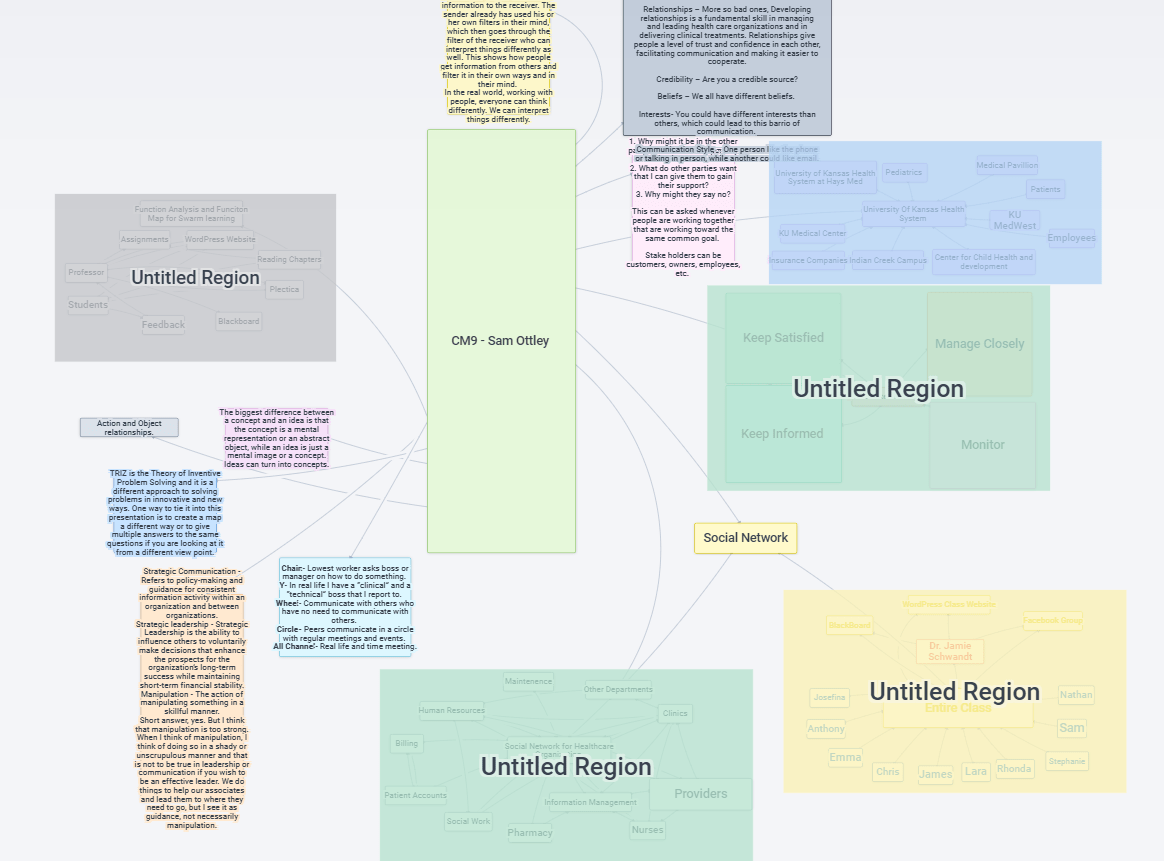I feel like I made this map a mess!
Link: https://www.plectica.com/maps/O4TF4P4ST
- What is the sender, receiver, feedback model and how does it apply to you?
The sender sends feedback or information to the receiver. The sender already has used his or her own filters in their mind, which then goes through the filter of the receiver who can interpret things differently as well. This shows how people get information from others and filter it in their own ways and in their mind.
In the real world, working with people, everyone can think differently. We can interpret things differently.
- What are examples of barriers to communication in health care?
Curse of Knowledge—the problem of imagining another person’s state of mind when you have a piece of knowledge that they lack
Relationships – More so bad ones, Developing relationships is a fundamental skill in managing and leading health care organizations and in delivering clinical treatments. Relationships give people a level of trust and confidence in each other, facilitating communication and making it easier to cooperate.
Credibility – Are you a credible source?
Beliefs – We all have different beliefs.
Interests- You could have different interests than others, which could lead to this barrio of communication.
Communication Style – One person like the phone or talking in person, while another could like email.
- When conducting a stakeholder analysis — or just simply thinking about your stakeholders’ interests in a systematic way — what are three important questions to ask? How do you see these questions being asked in health care? And who are the stakeholders?
- Why might it be in the other party’s interests to support my idea?
- What do other parties want that I can give them to gain their support?
- Why might they say no?
This can be asked whenever people are working together that are working toward the same common goal.
Stake holders can be customers, owners, empoyees
- Create a stakeholder map for a health care organization and describe it — similar to the map on p. 173 of your textbook.
- Create a Power-Interest Matrix for a health care organization and describe how you would create one.
- Describe what a social network is. Use this class as an example. Then create a social network for this class — similar to the one on p. 178 of your textbook.
- Create a social network for a large health care organization — similar to the one on p. 178 of your textbook
- Describe what the different communication networks are and provide examples of them.
Chain- Lowest worker asks boss or manager on how to do something.
Y- In real life I have a “clinical” and a “technical” boss that I report to.
Wheel- Communicate with others who have no need to communicate with others.
Circle- Peers communicate in a circle with regular meetings and events.
All Channel- Real life and time meeting.
- Is strategic communication or leadership simply just manipulation? Define the three: strategic communication — leadership — manipulation. Then discuss your answer.
Strategic Communication – Refers to policy-making and guidance for consistent information activity within an organization and between organizations.
Strategic leadership – Strategic Leadership is the ability to influence others to voluntarily make decisions that enhance the prospects for the organization’s long-term success while maintaining short-term financial stability.
Manipulation – The action of manipulating something in a skillful manner.
Short answer, yes. But I think that manipulation is too strong. When I think of manipulation, I think of doing so in a shady or unscrupulous manner and that is not to be true in leadership or communication if you wish to be an effective leader. We do things to help our associates and lead them to where they need to go, but I see it as guidance, not necessarily manipulation.
- What is TRIZ and how can you use the tools discussed in this presentation?
TRIZ is the Theory of Inventive Problem Solving and it is a different approach to solving problems in innovative and new ways. One way to tie it into this presentation is to create a map a different way or to give multiple answers to the same questions if you are looking at it from a different view point.
- What is conceptual thinking? And what is the difference between an idea and a concept?
Conceptual Thinking – The ability to analyze hypothetical situations or abstract concepts to compile insight.
The biggest difference between a concept and an idea is that the concept is a mental representation or an abstract object, while an idea is just a mental image or a concept. Ideas can turn into concepts.
- What are the components of a function analysis and a function map?
Action and Object relationships.
- Build a Function Analysis and Function Map for this class (Swarm Learning).

Fantastic job!